Before you panic in Japanese toilets! Tourists are surprised by Japan’s toilet-advanced status 🚽✨
Japanese toilets are known worldwide for their high-tech and cleanliness. Many tourists are amazed by their sophisticated features, such as automatically opening toilet seats and heated toilets. However, the cultural background and diverse functions of Japanese toilets often confuse foreign tourists.
The other day, I came across a shocking sight in a public restroom at the Nakasu Cruise Terminal in Hakata, a famous tourist spot in Fukuoka. There was a mountain of used toilet paper piled up in the corner of each stall. This was a tragic example of a misunderstanding born out of cultural differences. Japanese restrooms are only equipped with small trash cans for sanitary products, so people who are used to throwing away toilet paper have no choice but to pile it up there.
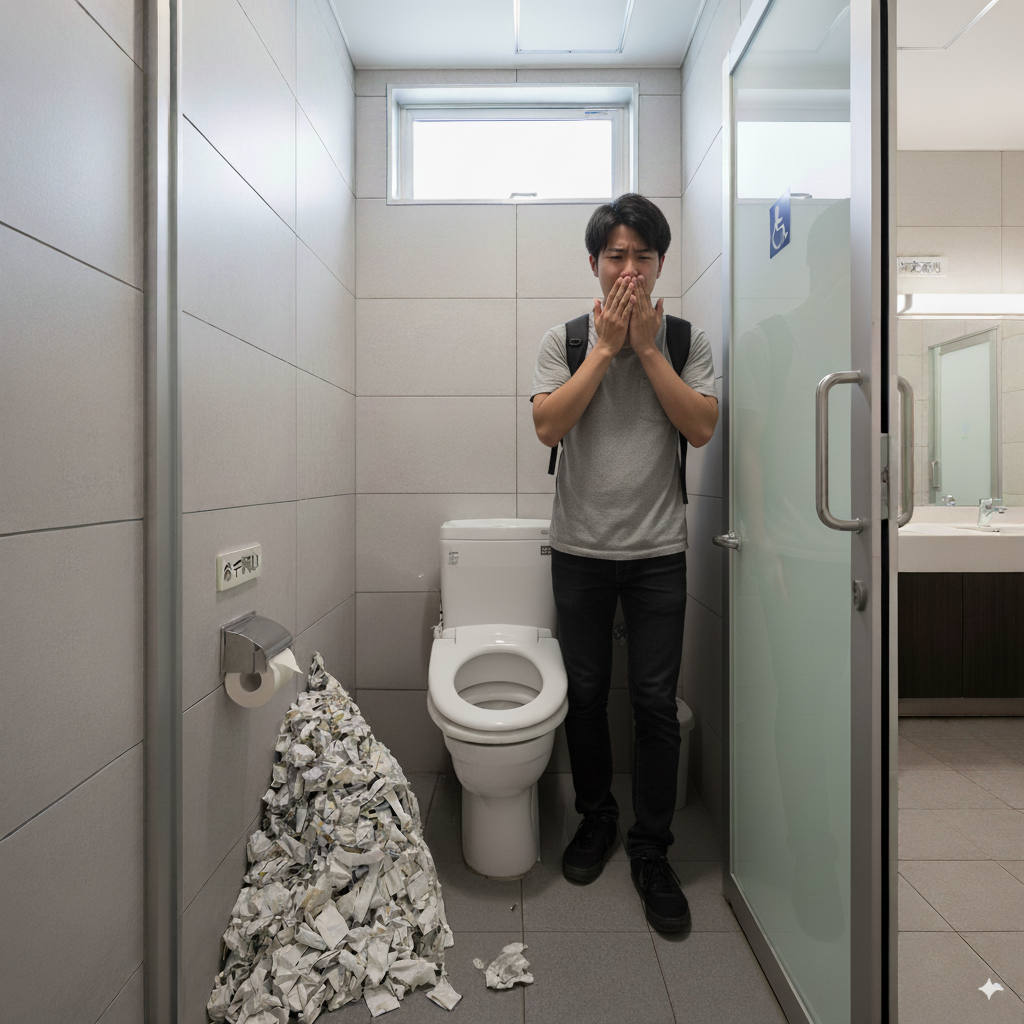
In this article, I will explain three surprising facts you should know to use Japanese toilets smoothly and avoid these cultural misunderstandings, based on my own experiences. After reading this, you will never have to panic in a Japanese toilet again!

- Flush toilet paper in the toilet, not the trash can
- There are so many ways to flush! Where is the “flush” button?
- The true identity of the mysterious “Otohime” button🔊
- Now you’re a toilet expert! Use a heated toilet seat!
- Use of disinfectant cleaners🧹
- Various sanitary boxes
- Useful etiquette for convenience store restrooms🏪
- ⭐summary⭐
Flush toilet paper in the toilet, not the trash can
In Japan, it is common sense to flush used toilet paper down the toilet.
If you take away just one thing from this article, it might be this. The root cause of the dirty toilets in Fukuoka mentioned at the beginning was precisely this difference in customs. In many Asian countries, due to plumbing issues, it is common to not flush toilet paper down the toilet, but to throw it in a trash can installed in the stall.
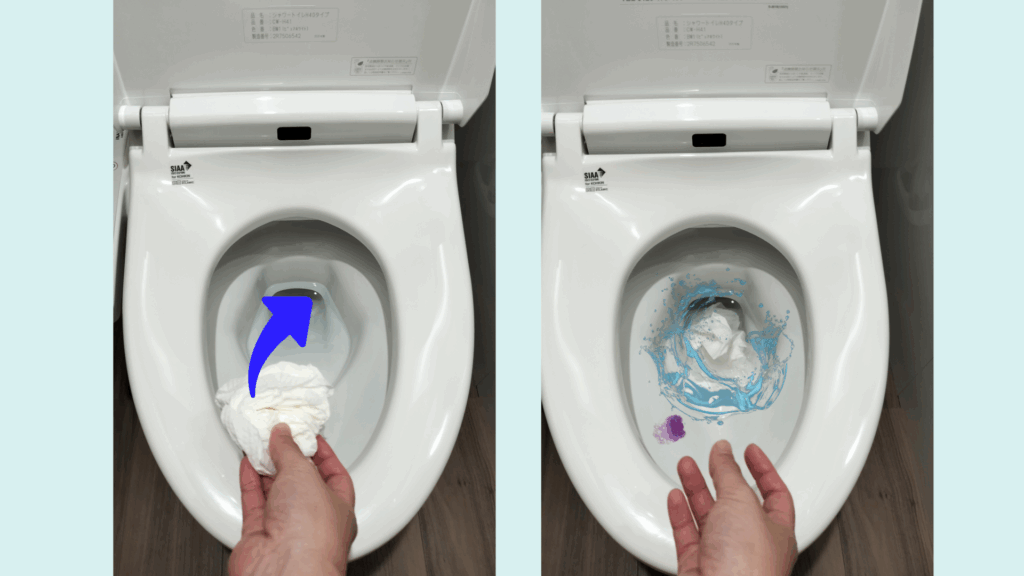
However, Japanese toilet paper is specially made to dissolve easily in water, so you can flush it down the toilet without worrying about it clogging.
In fact, there are no designated trash cans, so please be aware of this at the time. Throwing used paper lying around can cause bad odors and lead to the development of insects, making it extremely unsanitary. In Japan, where there is a deep-rooted culture of consideration for the next user so as not to cause discomfort, always flush used toilet paper down the toilet.
However, you should not flush anything down the toilet. If you flush sanitary products or regular tissue paper down the toilet, it will cause the toilet to break down. Only flush toilet paper that is provided.
There are so many ways to flush! Where is the “flush” button?
I have personally helped tourists who were panicking at the airport because they didn’t know how to flush the toilet. The variety of ways to flush Japanese toilets is a major source of confusion for many travelers. Here we will introduce the main types.
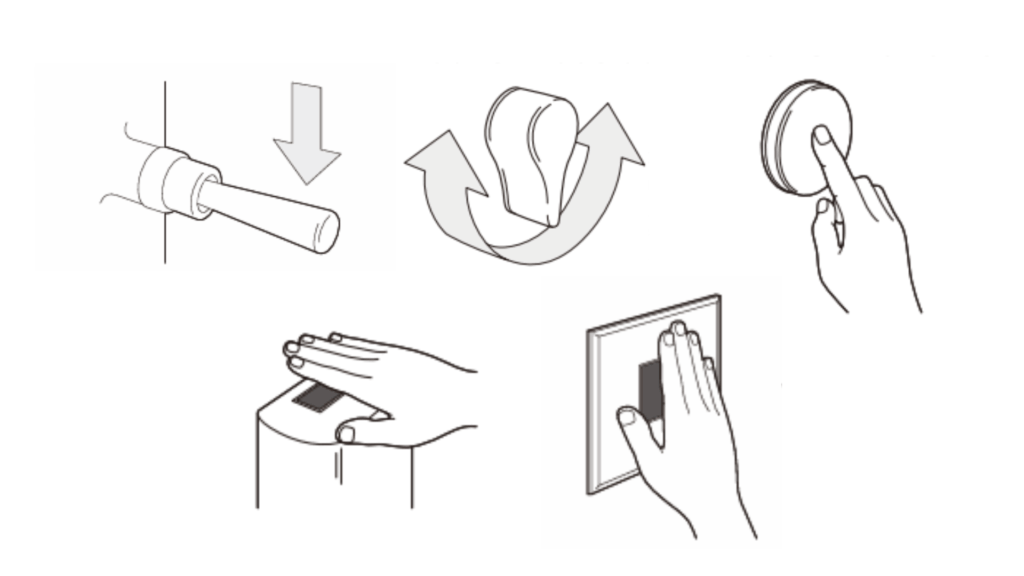
Lever handle type👊
Although this is an old-fashioned type, there are actually two types. One is a rod-shaped lever that protrudes from the toilet’s pipes; you flush by pushing down on this. It may be hidden behind the toilet seat lid, so if you can’t find it, try looking behind it. The other type is a small lever that you turn on the side or front of the tank. This type is sometimes labeled “large” or “small,” and allows you to adjust the amount of water depending on the situation. This is another expression of a culture that values resources.


Wall button type▶️👈
This type has a flush button installed on the wall. There are various designs,“F L U S H” “emergency red SOS button“. Please be careful not to press the wrong button by mistake. This will sound an alarm and call for many staff members to rush to the scene. Those who cannot read Japanese may easily mistake the conspicuous red button for the flush button, but please be careful.


Remote control type📟
This type has a flush button on the wall-mounted remote control. With many buttons, including the bidet function, it may be difficult to tell which is the flush button. The flush button is often located at the top of the remote control. This type may also have buttons for finely adjusting the water volume, such as “large,” “small,” and “eco-small.”
There are various ways to write the “flush button” in Japanese, so be sure to remember the most common characters. Japanese toilets have many buttons and the writing is often only in Japanese, so knowing these will help you avoid panicking.

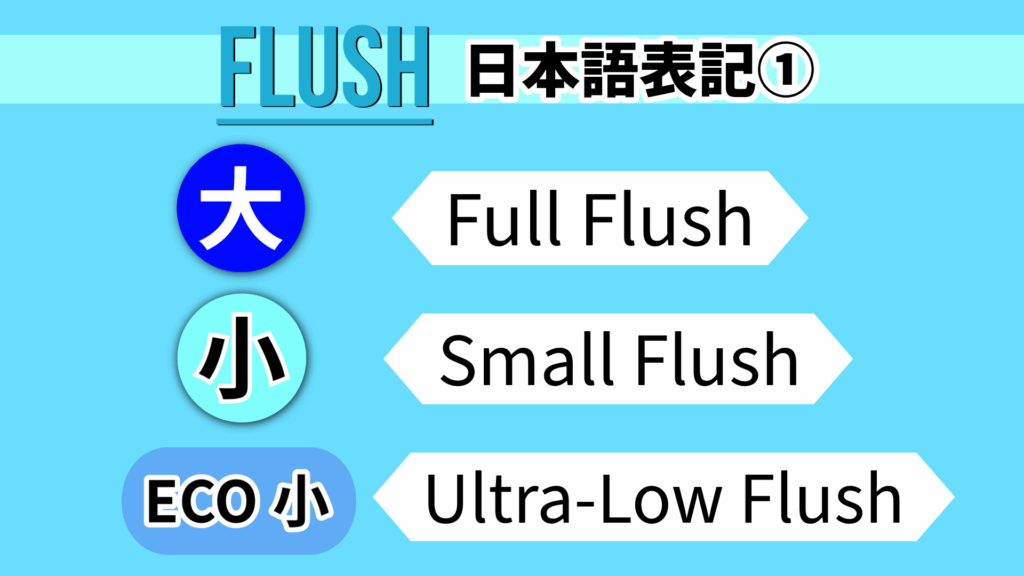

Sensor type🤩
This is a contactless type where water flows when you hold your hand over a sensor on the wall or behind the toilet seat. This is the type that a tourist I helped at the airport was having trouble with. If you can’t find the lever or button, try looking for the sensor.

Automatic cleaning type
When you stand up from the toilet seat, the water flushes automatically. Many tourists are amazed by this feature, as there is no need to operate it yourself. I was truly amazed when I tried it for the first time.
By the way, there are also men’s urinals with buttons on the top and automatic flushing types. Button-type urinals are usually located at the top, so they should be easy to find.

The true identity of the mysterious “Otohime” button🔊
A mysterious button often seen in Japanese restrooms, especially women’s restrooms, is called “Otohime.” This is a function that drowns out the sounds of using the toilet with an imitation of the sound of running water. Now, it’s become such an essential feature for me that I’m disappointed when I go to a restroom that doesn’t have Otohime.

Even in toilets that don’t have Otohime installed, there are people who relieve themselves by listening to the Otohime videos posted on YouTube.
You might be surprised to hear the sounds of a Japanese toilet for the first time, so if you’re curious, check it out on YouTube!
The background to the creation of this unique feature was the custom of Japanese women, who were embarrassed about the noise they made, of flushing the toilet multiple times between uses to reduce the noise. Before Otohime became popular, I also did the same. As this custom spread, and a severe drought occurred, water waste became a problem. Otohime was created to solve this problem.Great inventions that solve social problemsThat’s it 💡
There are various types of Otohime, such as a button-operated system, a system where you wave your hand over a sensor, and a system that automatically starts making a sound when you enter the stall. Also, even if you can’t find it on the remote control on the wall, it may be hidden on the side panel of the toilet seat, so don’t give up and keep looking.
This culture of “hiding sounds” seems to have existed since ancient times, and one theory is that during the Edo period, women of high social status used a device called an “oto no hashi tsubo” (sound basin), which ran water from a faucet to muffle sounds.
Now you’re a toilet expert! Use a heated toilet seat!
Many Japanese toilets have a warm water washing function, and there are many buttons to explain it. With just one button, you can wash your bottom with warm water, which is an essential feature for Japanese people.
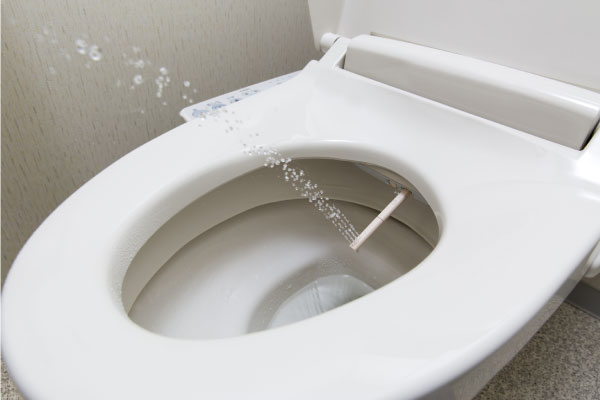
Butt washing button
This is the most common button for washing your bottom. When you press this button, the nozzle will automatically come out and water will come out. Be sure not to stand up after pressing the button. Also, as I will explain later, you can adjust the water pressure, so make sure it is not set to the strongest setting before pressing the button. The strongest setting is quite strong, so you may be surprised. I prefer the weakest setting 💗

A button that gently washes the bottom with gentle water pressure
Some models have this button, while others don’t, but if it does, it will clean your bottom with a gentler water pressure than a regular bottom wash. This is recommended for those with sensitive skin. Also, even if there is no “soft” button, there are some models that will switch to “soft mode” by pressing the “bottom” button twice.

Genital cleaning button 👧
This button is often used by women. The nozzle comes out further forward than the normal “butt” mode. This is a very useful feature for women who are menstruating. It is safe because it comes out with a dedicated bidet nozzle, separate from the nozzle that comes out in the normal “butt” mode. You can also adjust the water pressure here.

Button to adjust the water pressure
These are the buttons to adjust the water pressure of the “bottom” and “bidet.” The previous user may have set it to the strongest setting, so it’s a good idea to check first what setting it is! The strongest setting can be painful!

Button to adjust the nozzle position
This button may or may not be present, but it allows you to finely adjust the nozzle position.

Air drying button 🌬️
This button may or may not be there, but it blows out air to dry your bottom.

Stop button
This is the button that stops all operations. If you don’t have this button, you can often stop it by pressing each button again, so if there is no button to stop it, try pressing the same button again⏹️👈👈
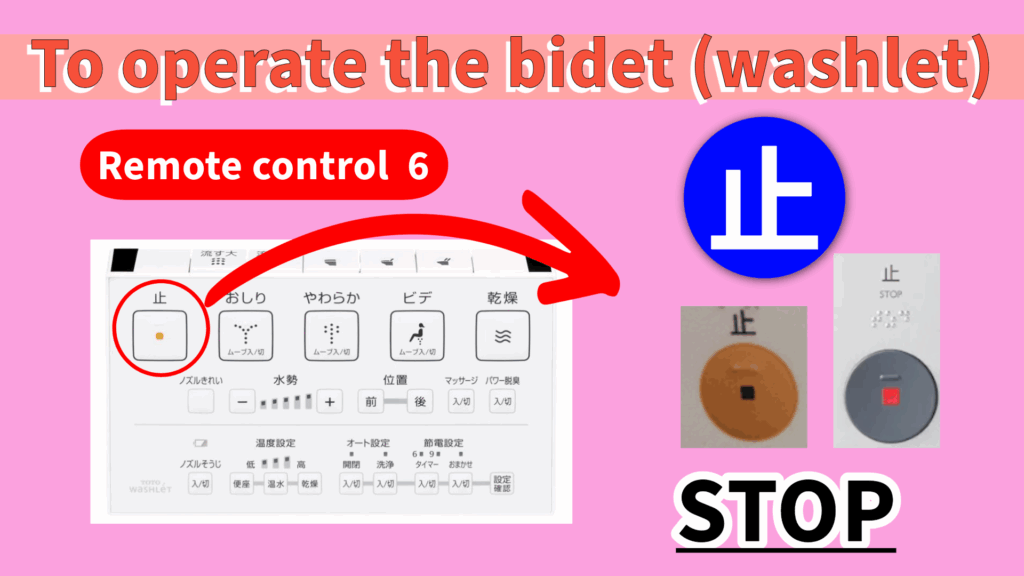
Remote control next to the toilet seat
If there is no remote control on the wall, there is a good chance that it is next to the toilet seat.

Use of disinfectant cleaners🧹
Many Japanese toilets are equipped with “seat cleaners” for disinfecting toilet seats. They have been around in Japan since before the global coronavirus pandemic. Because people are highly conscious of personal hygiene, they are widely used.

They’re simple to use: take an appropriate amount of toilet paper, press the button on the seat cleaner, and let the paper soak in the cleaner to disinfect the seat, buttons, doorknobs, and other surfaces. Be sure to use them before use, and also after you’ve made a mess.
Various sanitary boxes
All women’s restrooms are equipped with sanitary boxes. They are generally placed in the corner of the stall. There are small, simple plastic types, medium-sized types that open the lid by stepping on them, and automatic types that open the lid by holding your hand over a sensor. Wrap the waste up in a small container and then throw it away in the appropriate sanitary box. The automatic types are very convenient as you can throw it away without having to touch the box at all.


Useful etiquette for convenience store restrooms🏪
Public toilets in Japan are generally free to use, but when you’re in a hurry in the city, the most convenient option is a convenience store toilet.
However, convenience store toilets are provided as a customer service service by the store, and are not public facilities. Therefore, as a token of appreciation for being allowed to use the toilet, It is polite to buy small things like gum or drinks.。
Furthermore, you can make a better impression by asking the staff, “May I use the restroom?” before using the restroom.

⭐summary⭐
In this article, we’ve explained some points about Japanese toilets that can be confusing for tourists visiting Japan.
- Flush toilet paper down the toilet, not in the trash.
- There are various types of cleaning methods, including lever, button, sensor, and automatic.
- “Otohime” is a noise-canceling feature and a cultural device for saving water.
At the very least, you need to know these three things!Japanese toilets may seem complicated at first glance, but each and every function is packed with uniquely Japanese ingenuity, such as consideration for the next user and ways to conserve resources. If you know these points, you should be able to use Japanese toilets comfortably and with a deeper understanding of the culture.
Besides Japanese toilets, are there any other small innovations in Japanese culture that you find interesting? Please let us know in the comments or via DM on social media!




コメント